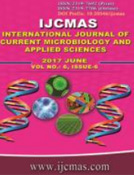


 National Academy of Agricultural Sciences (NAAS)
National Academy of Agricultural Sciences (NAAS)

|
PRINT ISSN : 2319-7692
Online ISSN : 2319-7706 Issues : 12 per year Publisher : Excellent Publishers Email : editorijcmas@gmail.com / submit@ijcmas.com Editor-in-chief: Dr.M.Prakash Index Copernicus ICV 2018: 95.39 NAAS RATING 2020: 5.38 |
Genetic diversity among 28 sesame (Sesamum indicum L.) varieties was examined at DNA level by means of random amplified polymorphic DNA (RAPD) analysis. Fifteen primers used produced a total of 132 RAPD fragments. Each primer generated 3 to 26 amplified fragments with an average of 8.8 bands per primer. Based on pair-wise comparisons of RAPD amplification products, Nei and Li’s similarity coefficients were computed to assess the associations among the varieties. Pair-wise similarity indices varied from 0.35 to 0.84. A UPGMA cluster analysis based on these genetic similarities located most of the varieties far apart from one another, showing a high level of polymorphism. Genetically, all the genotypes were classified into two major groups at similarity coefficient 0.35 and these major groups are further divided into small clusters as the similarity coefficient level increases. Accession Swetha Til and AKT-101 was show maximum distance from each other. In conclusion, even with the use of a limited set of primers, RAPD technique revealed a high level of genetic variation among sesame varieties. This high level of genetic diversity among the genotypes suggested that RAPD technique is valuable for sesame systematic, and can be helpful for competent choice of parents in breeding programs.
 |
 |
 |
 |
 |